Almost everyone alive today, and almost everyone who has ever lived, has watched the Sun go round the Earth. But today most people, everywhere in the world, have been told that the Earth goes round the Sun. This is the story of how and why, at the beginning of the 17th century CE, ordinary Europeans began to believe not what they actually saw but what they had been told. People in all other parts of the World have also come to believe it, either by being told it by Europeans or in other ways and at other times - Europeans have never had a monopoly of astronomy!
To children growing up in the 21st century CE it is obvious that the Earth goes round the Sun: there is a poster showing it on the wall of their classroom, and they have watched tv and seen spacecraft going to Mars and beyond Neptune, and watched videos of galaxies colliding and seen photographs of the Earth and Moon taken from Mars. And of course they have been told it by their teachers at school and their parents at home. But just suppose telescopes, and aeroplanes and rockets and spacecraft and Earth satellites and radio and television and computers and mobile phones had never been invented, and all books on astronomy were written in Latin or Arabic: the only things you could know about astronomy were the things you could see for yourself by looking at the Night Sky from the surface of the Earth...
By the end of the 16th centure CE most ordinary Europeans had a model of the Universe in which the Earth was at the centre, and the Sun, and the Moon, and Mercury and Venus and Mars and Jupiter and Saturn and all the stars went round it in circles: this is a geocentric universe, from the Greek for the Earth in the middle. This model explained, to their satisfaction, why the Sun and Moon and everything else in the sky rose and set, it explained the phases of the Moon, the tides, the seasons, in fact almost everything that actually mattered to them. The one thing it did not explain very well was planetary motion - and that did not matter to them.
Exactly. Most children living in the 21st century have never heard of planetary motion, let alone watched it for themselves, but everyone living at any time before the end of the 16th century CE would have been totally familiar with it.
To them the Night Sky was something they saw every night, so the way in which Mars and Jupiter and Saturn move through the constellations, from Pisces to Aries to Taurus etc, sometimes in one direction and sometimes in quite the opposite direction, would have been as familiar to them as something like Coronation Street is to many people today. This motion is fully explained on the Page on Mars.
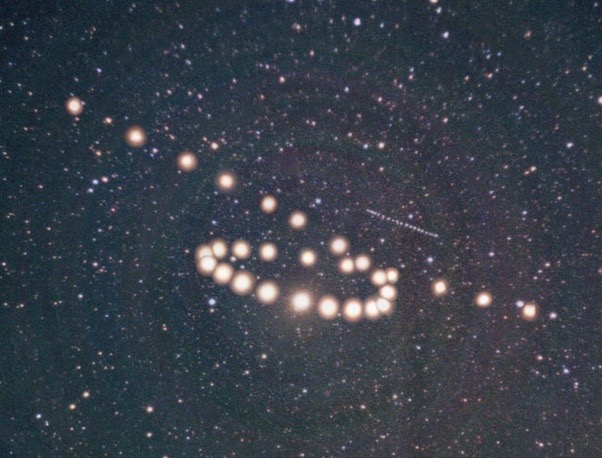
In the above paragraphs ordinary people means the 17th century equivalent of today’s bus drivers and junior school teachers and hairdressers and shop assistants and nurses and plumbers, in fact almost everyone except people with masters’ degrees in astrophysics. They could watch planetary motion, but the fact that they did not understand it did not bother them, in the same way that today most people see the water start to swirl round when they pull the plug out of the bath or basin or sink but it does not bother them. But from time to time, going back more than three thousand years, there had been a few astronomers who it did bother. One solution which they came up with involved a universe with the Earth in the middle, and the Sun and Moon going in circles round it, but Venus and Mercury and Mars and Jupiter and Saturn moving not in circles round the Earth but each in a circle with its centre moving in a circle round the Earth, like the drawings produced by a Spirograph.

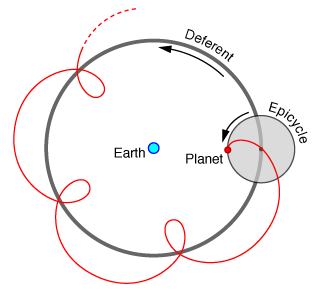
You can see some more wonderful drawings produced in this way by doing a web search, or download an app to make your own, or of course buy your own Spirograph.
Adjusting the size of the two “cogs” (the early astronomers actually used 3-D spheres rather than 2-D cogs) for each planet produced a rough approximation to their planetary motion. You could get better results for each planet by using a different and more complicated arrangement of spheres. It continued to be developed and by the end of the first century CE some astronomers were producing reasonably good predictions of the motions of Mars, Jupiter and Saturn through the fixed stars.
This arrangement has become known as the Ptolemaic System, after the Greek philosopher Ptolemy (about 100 - 170 CE), although it had actually originated some time before him. In Europe it was the standard explanation of planetary motion for the next one thousand five hundred years, although during this time there were enormous developments in mathematics and astronomy and other sciences taking place in the Arabic World.
But these arrangements were very complicated and involved very difficult mathematics, particularly for Mars. A few astronomers, going back to a Greek called Aristarchus (310 - 230 BCE), had realised that a system in which the Moon went in a circle round the Earth, but Mercury and Venus and the Earth and Mars and Jupiter and Saturn went in circles round the Sun would explain planetary motion just as well, and make their sums much easier - this is a heliocentric universe, one with the Sun in its centre.
Just one, really big, problem: it does not explain why the Sun and Moon rise and set! To explain this you need people to start to believe not only that the Earth is going round the Sun but also that it is revolving on its axis! (This is something which many of today’s teachers and books on the subject forget to tell you.) Most other astronomers totally rejected this idea - how can you explain why everything is not thrown off? - think what happens when you put dry clay on a potter’s wheel.
Man has been making round pots on a potter’s wheel for at least seven thousand years, and until about two hundred and fifty years ago almost everyone would have seen one being used. There is much more about pottery, and Man’s other uses of clay, on another Page, but not on astronomy.
Here is a video of a potter’s wheel.
This potter’s wheel is powered by electricity, originally they were powered by a treadle operated by your feet.
The wet clay must be thrown onto the wheel with enough force to make it stick, otherwise it will just be flung off. So potters normally talk about throwing a pot. The 21st century equivalent of seeing what happens when you put dry clay onto a potter’s wheel would be using your Mum's kitchen blender without putting the lid on - but ask first. The reason why we are not thrown off the Earth as it rotates on its axis is explained on another Page.
After the pot has been made on the wheel it must be fired, this is described in the pottery section of the clay page.
It was not until just before his death that Nicolaus Copernicus (1473 - 1543) plucked up the courage to publish his book “On the revolution of the Celestial Spheres” in which he said that the Earth and planets did go round the Sun, and started what is called the Copernican Revolution. He was not the first person since Aristarchus to hold this idea but he was the first European to publish a book about it - book-printing had not been introduced into Europe until about 1440 CE. In his Book Copernicus gives the names of some of the Arabic mathematicians and astronomers whose writings he had studied.
Over the next sixty years more and more European astronomers came to accept the Copernican idea, but one problem remained: it was much simpler and a little more accurate than the old system in explaining planetary motion, but still not quite right, particularly for Mars.
The solution was the result of the unlikely co-operation between a wealthy Danish nobleman who believed that the Sun went round the Earth and a poor low-born German school-teacher who believed that the Earth went round the Sun. Their names were Tycho Brahe (1546 - 1601) and Johannes Kepler (1571 - 1630) - and at the time neither of them owned a telescope.
As we watch the sky we can see the Sun and Moon and stars and planets changing their positions in it. For thousands of years Man has tried to understand these movements, but we cannot begin to understand them until we have some way of measuring them. From the surface of the Earth the only thing we can measure is the angles between them, and between them and the horizon.
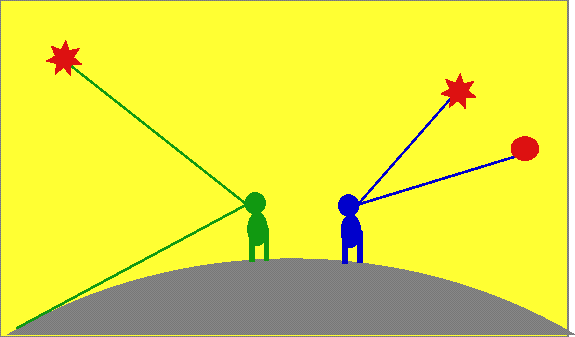
These angles change as the Moon goes round the Earth and the Earth rotates on its axis and the Earth and planets move round the Sun.
We measure angles in degrees, a sixtieth of a degree is a minute and a sixtieth of a minute is a second, but astronomers need to measure both times and angles, so to avoid any confusion they call a sixtieth of a degree of angle an arcminute, and similarly an arcsecond. We write forty four degrees ten arcminutes and twenty arcseconds as 44o10'20".
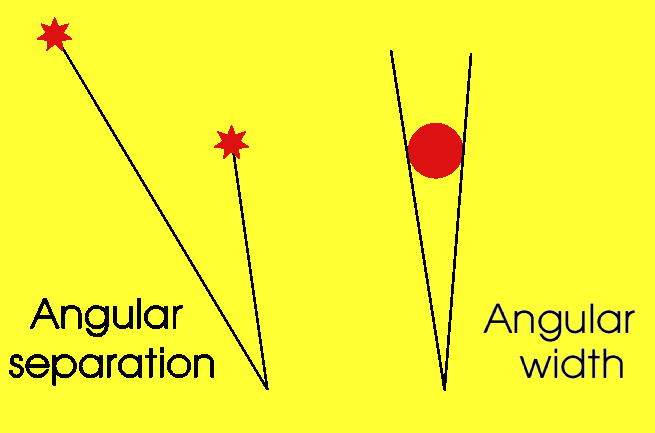
What we are actually measuring are what astronomers call angular separation and angular width, which by themselves tell us nothing about how far the stars are from the Earth or each other or how big they really are. For example, the three bright stars which make up Orion’s Belt look close together and in a straight line but they are actually very different: this drawing is very definitely not to scale!
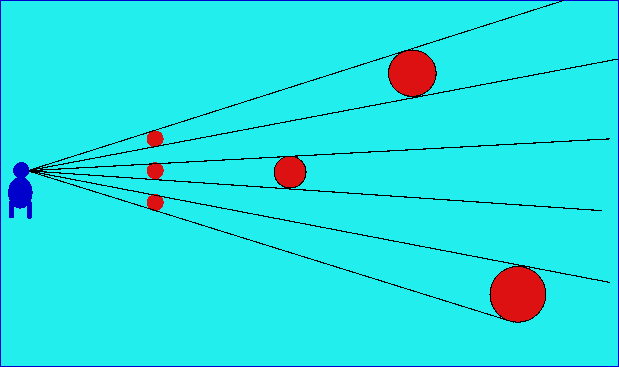
The normal human eye cannot resolve (separate) rays of light which enter it at a difference of less than about one arcminute, so the stars and planets appear as just points of light. One arcminute is equivalent to an object about thirty centimetres in diameter about a kilometre away, so we can see people a kilometre away but not recognise their faces. The Sun and Moon each have an angular diameter of about 30 arcminutes, or about half the width of your thumb when you hold out your arm - but do not look at the Sun unless it is very low in the sky or you can see it as a yellow disc through a cloud. The Sun’s diameter is about four hundred times that of the Moon but it is also about four hundred times further from the Earth so they appear exactly the same size - hence solar eclipses. Most people find this surprising: the Full Moon when it is rising looks much bigger than the Sun when it is high in the sky, but this is an optical illusion - to prove this for yourself just size it with your thumb.
Optical illusions are produced when our brain does not process what we see correctly. For example in this photograph the boy on the bicycle is the same size as the tower block but our brain knows that the tower block is actually much bigger than the boy, just much further away.

But sometimes our brain can get muddled up: it thinks it knows how far away something is, or how big it is, but it is wrong!
Lots of artists have painted pictures making use of optical illusions, and you can see some lovely ones by doing a web search on optical illusions in art - but take an adult with you.The Full Moon looks bigger when it is rising (so does the Sun when it is setting) because our brain becomes confused about its distance when we are looking at the Earth and Moon (or Sun) at the same time.
An ordinary school protractor is usually about 10 cm across, you can use it to measure angles to an accuracy of about half a degree. If you want to measure angles more accurately you must make it bigger: if you make it ten times bigger the markings will be ten times further apart so it will be ten times as accurate. A simple sighting tube might be a metre long, but it needs a stand of course and two protractors, one for up and down and one for round and round.
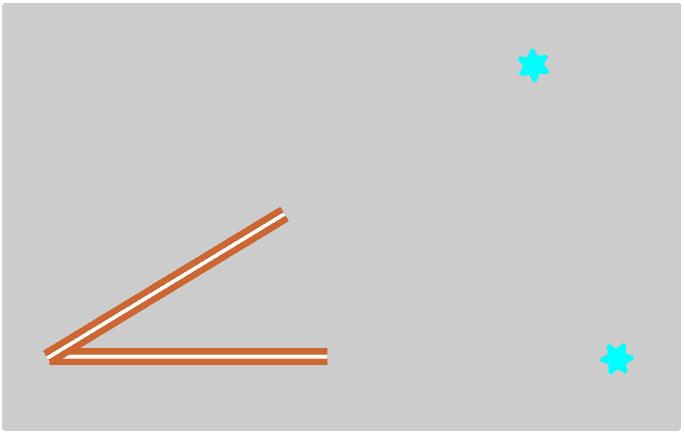
You can see a picture of ordinary people using cross-staffs to measure the length of a comet’s tail on the Comets Page. The earliest astronomical instruments were simple and small and light enough for one ordinary person to carry and use, but over the years as people tried to make them more accurate they got bigger and heavier and more difficult to carry and use, and eventually the most accurate could only be used by highly-trained astronomers and had to be housed in special purpose-built observatories.
By 1595 CE Tycho Brahe had an observatory with one particular instrument, a quadrant, from the Latin for a quarter of a circle, more than nine metres long. He could measure angles to an accuracy of better than one arcminute. It was the finest observatory in Europe, if not in the whole World.

The quadrant was in one of the large underground rooms, protected by a rotating cover, it did of course go round and round as well as up and down although on the drawing you can only just see the round and round scale.

He had made and kept the World’s most accurate measurements of the motions of the planets and stars over a period of more than twenty years. He himself always believed that the Sun went round the Earth but he allowed Kepler, who believed exactly the opposite, to have access to all his observations of the planets, and bequeathed them to Kepler on his death. Kepler used all these papers to show that the Earth and the other planets went round the Sun not in circles with the Sun in the centre but in ellipses with the Sun at one focus.
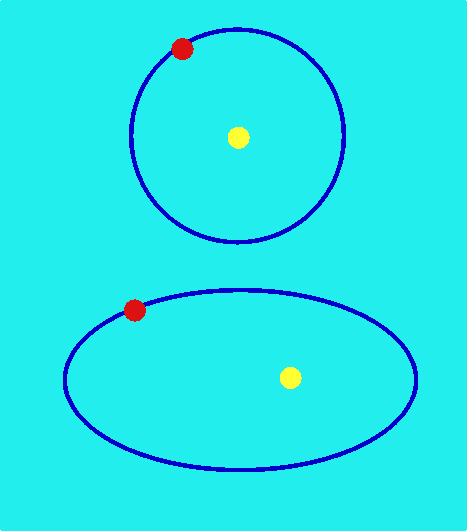
Circular and elliptical orbits are discussed more fully on the Comets Page. The Earth’s orbit is only very slightly elliptical, with an eccentricity of 0.01.
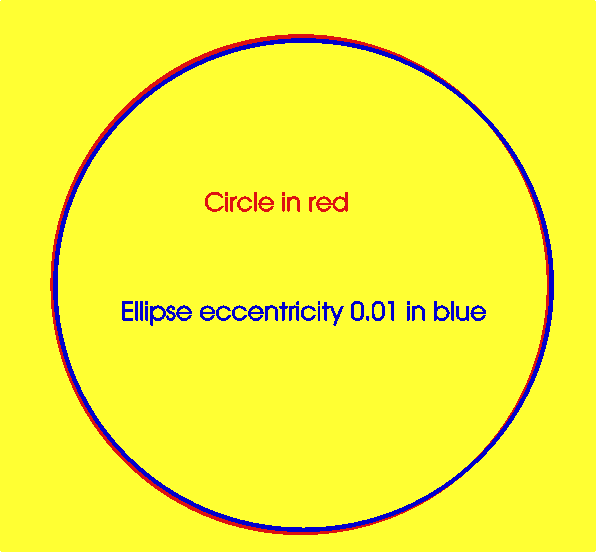
This gives some idea of the quite stunning accuracy of both Brahe’s measurements and Kepler’s calculations - no calculators or computers in those days!
The orbits of Mars, Jupiter and Saturn are slightly more elliptical.Kepler had finished his Laws of Planetary Motion, which explained planetary motion perfectly, in 1605 although because of the time it took to settle the estate of Tycho Brahe after his death in 1601 he could not actually publish them until 1609. Their publication finally justified astronomers’ belief in the heliocentric universe.
Galileo and his telescope had no part at all in this.
Galileo Galilei (1564 - 1642) was a very great scientist and made many discoveries. He did not invent the telescope - that was a Dutchman called Hans Lippeshey - but he made some improvements to it, and in 1609 was the first person to point a telescope at an object in the sky. His telescope was still a terrestial telescope, one designed for looking at things on the Earth, but in 1611 Kepler improved the design still further and produced the world’s first astronomical telescope, one made specifically for looking at objects in the sky.Galileo was a very great scientist and carried out lots of experiments and made many important discoveries in almost every area. He invented a timing mechanism to help doctors take a pulse, and a mechanism for pumping water out of an aquifer to irrigate a field, he designed a new gunsight for cannons to improve their accuracy, he made the World’s first thermometer, he did experiments on falling bodies and floating and sinking, and produced more accurate tide tables, and much much more. Like the telescope, he did not invent the microscope but he greatly improved it and did a lot of work on small living things such as insects and pond life with it. By 1612 he was the most famous scientist in Europe, and he remained so, producing new ideas and inventions, for the next thirty years, until his death in 1642.
He came very close to formulating a theory of gravity: Newton actually published his Theory of Gravity in 1687 although he had developed the idea as early as 1665, less than twenty five years after Galileo’s death. Newton said of himself “If I have seen a little further it is by standing on the shoulders of giants”.It is important for us to remember that before the first use of the telescope to look at the sky the Earth-centred universe explained everything that people could see in the sky except planetary motion: the only reason for asking people to believe that the Earth went round the Sun when everyone in the world could actually see the Sun going round the Earth was that it made astronomers’ sums easier when working out the motion of Mars. Supporting the Copernican Theory was an incredibly courageous act, and Copernicus himself had only allowed his Book to be published just before his death. Many, perhaps most, astronomers accepted Copernicus long before 1609, when Galileo first pointed his telescope at the stars, but were afraid to say so openly. In 1595 (forteen years before he pointed his telescope at the sky for the first time) Galileo had written a letter of encouragement to Kepler, a much younger man, saying that he himself had come to accept Copernicus several years earlier, but he did not publicly acknowledge that he accepted Copernicus until 1612, by which time he was the most famous scientist in Europe. But once he and then other astronomers started pointing telescopes at the sky they began to make lots of other wonderful discoveries which could only be explained in terms of a system with the Sun in its centre, and they felt free to be more open about their beliefs. Initially they thought of the Sun as the centre of the whole Universe but very quickly they realised that it was only the centre of what we now call the Solar System, and that our Sun was just one of many stars.
Tycho Brahe had died, suddenly and unexpectedly, in 1601. He never accepted Copernicus, but he had a very good reason for not doing so, and this is discussed later.
Galileo used his telescope to produce what he called his Three Proofs of the heliocentric system.
Whatever Mr Carpenter may say, Galileo was adamant that his discoveries with his telescope proved that Copernicus was right: he never claimed for himself any credit for the ideas of Copernicus.
Whatever Mr Carpenter might be teaching today, Tycho Brahe and a few other sixteenth and seventeenth century astronomers who publicly rejected Copernicus were not idiots, they had a very good reason for doing so.
We see different objects in different positions because the rays of light from them come into our eyes at different angles: if an object moves we shall see it in a different position. But we shall also see objects in different positions if we move our position.
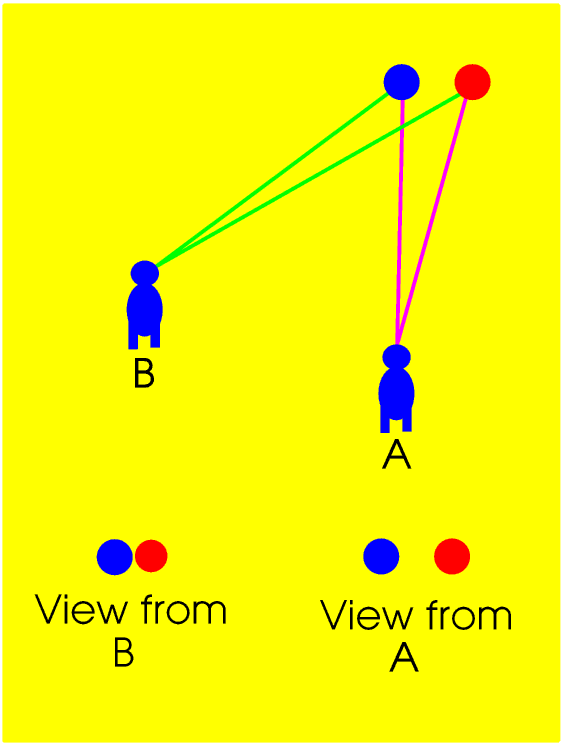
This apparent movement is called parallax.
You do not need to move very far, you do not even need to get out of your chair. Look at anything at least two arms lengths away. Stretch out one arm and shut one eye and using the other eye cover the object with your thumb. Now change eyes - your thumb has moved!If the Earth really did move round the Sun we would expect the stars to show parallax between Summer and Winter.
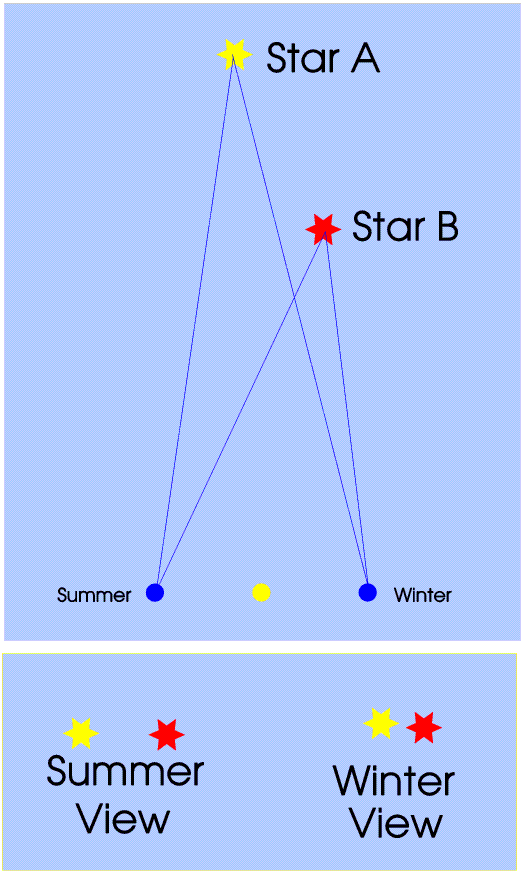
Tycho Brahe had by far the most accurate measurements of the positions of the stars over long periods of time, so if anyone could detect stellar parallex it would be him. He looked for it but he could not find it: he had to reject Copernicus.
To get the picture onto your screen on this drawing the nearest star is shown about four times as far from the Sun as the Earth. In real life it is actually about two hundred and fifty thousand times as far from the Sun as the Earth: stellar parallax does exist but it is so tiny that 16th and 17th century astronomers did not have instruments sensitive enough to measure it. Astronomers had been looking for it ever since Copernicus had published his Book but it was not actually detected for nearly three hundred years, in 1838, by which time astronomical telescopes could measure angles to an accuracy of a quarter of an arcsecond. Galileo and Kepler and the other astronomers who accepted Copernicus had realised that the Universe was so big and the stars were so far away that stellar parallax was too tiny for their instruments to measure, but Brahe simply could not accept that anything could be that big.
The 21st century Universe is far far bigger than anything that Kepler and Galileo and other seventeenth century astronomers could have imagined: today’s astronomical telescopes need to be able to resolve angular differences of less than a millionth of an arcsecond!

© Barry Gray October 2022